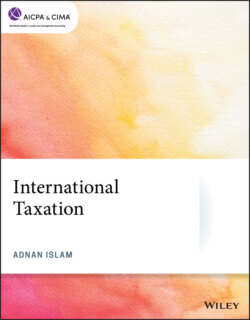Читать книгу International Taxation - Adnan Islam - Страница 58
Functional currency
ОглавлениеBoth FASB Statement No. 52, Foreign Currency Translation, and Section 985 of the IRC define an entity’s functional currency as the currency of the primary economic environment in which a significant part of such unit’s activities are conducted (a QBU) and which is used by such unit in keeping its books and records. Translation gains and losses result from exchange rate changes on transactions denominated in currencies other than the functional currency.
The economic environment of a QBU’s activities is determined from facts and circumstances, the analysis of which is driven primarily by the currencies in which the QBU (a) accrues revenues and incurs expenses, (b) collects revenues and pays expenses, (c) borrows and lends, and (d) makes pricing and other financial decisions. The location of a QBU’s principal place of business is also important, as are the duration of a QBU’s activities and the volume of its independent activities, because use of a currency is premised upon a long-term commitment to a specific environment. Whether a foreign activity is of sufficient duration to be a QBU depends, in part, on whether the host country taxes those activities.
A functional currency is a method of accounting, and adoption of or election of a new functional currency is a change of accounting method, normally accomplished only with consent of the IRS. Permission to change is usually given only if significant changes have occurred in the facts and circumstances of the QBU’s economic environment.
The functional currency of any QBU must be the dollar if activities are primarily conducted in dollars. The taxpayer may elect to use the dollar as the functional currency of any QBU if that unit keeps its books and records in dollars or the taxpayer uses a method of accounting that approximates a separate transactions method, that is, each transaction of the unit can be converted to dollars. In addition, Treasury Regulation 1.985-1(a) provides that the dollar shall be the functional currency of the following: (a) any taxpayer that is not a QBU, for example, an individual, (b) a QBU that conducts its activities primarily in dollars, (c) a QBU that has the United States, or any possession or territory of the United States where the dollar is the standard currency, as its residence, (d) a QBU that does not keep books and records in the currency of the economic environment in which a significant part of its activities are conducted, or (e) any activity (wherever conducted and regardless of its frequency) that produces income or loss that is or is treated as effectively connected with the conduct of a trade or business within the United States.
The functional currency of a QBU that is not required to use the dollar will be the currency of its economic environment in which a significant part if its activities are conducted, provided the QBU keeps its books and records in that currency. The economic environment in which a significant part of a QBU’s activities are conducted is a facts and circumstances determination. These facts and circumstances may include, among others, the currency of the country in which the QBU is a resident, the principal currency of the QBU’s cash flows, the principal currency in which the QBU generates revenues and incurs expenses, the principal currency in which the borrowing or lending of the QBU is conducted, the currency of the QBU’s principal sales market, the duration of the QBU’s business operations, and the significance or volume of the QBU’s independent activities. If, for purposes of generally accepted accounting principles (GAAP), a determination of functional currency is made based on these same facts and circumstances, that currency ordinarily will be accepted as the functional currency for income tax purposes.
A QBU is presumed to keep books in the currency of the economic environment in which a significant part of its activities are conducted. This presumption may be overcome by demonstrating to the satisfaction of the District Director of the IRS that a substantial nontax purpose exists for not keeping any books and records in the currency of that environment. A QBU that has more than one currency that satisfies the functional currency tests may choose any such currency as its functional currency.
A foreign corporation that has more than one QBU, all of which do not have the same functional currency, will be treated as having a single functional currency as a whole that may be different from the functional currency of one or more of its QBUs. The determination of such a corporation’s functional currency is done by applying the following two steps: (a) determine the functional currency of each QBU and (b) determine the functional currency of the foreign corporation as a whole.
The income or loss of a foreign corporation with one or more of its QBUs having a different functional currency is determined by calculating the income or loss, or earnings and profits, or deficit in earnings and profits, of each QBU in its functional currency using the profit-and-loss method described in Section 987. The amount of each QBU’s income or loss, or earnings and profits, or deficit in earnings and profits, is then translated into the foreign corporation’s functional currency using the appropriate exchange rate for determining the corporation’s income or earnings and profits.
